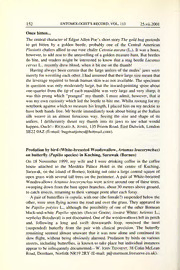
Predation by bird (White-breasted Woodswallow, Artamus leucorynchus) on butterfly (Papilio species) in Kuching, Sarawak (Borneo) PDF
Preview Predation by bird (White-breasted Woodswallow, Artamus leucorynchus) on butterfly (Papilio species) in Kuching, Sarawak (Borneo)
1 152 ENTOMOLOGIST'S RECORD, VOL. 113 25.vii.200 Once bitten... The central character of Edgar Allen Poe's short story The gold bug pretends to get bitten by a golden beetle, probably one of the Central American Plusiotis chafers allied to our rose chafer Cetonia aurata (L.). It was a hoax, however, to add zest to the unravelling of a golden treasure hunt. But beetles do bite, and readers might be interested to know that a stag beetle Lucanus cervus L., recently drew blood, when it bit me on the thumb! Having always been certain that the large antlers of the males' jaws were merely for wrestling each other, I had assumed that their large size meant that the leverage required to break human skin was not available. The specimen in question was only moderately large, but the inward-pointing spine about one-quarter from the tip of each mandible was very large and very sharp; it was this prong which "pranged" my thumb. I must admit, however, that it was my own curiosity which led the beetle to bite me. Whilst rooting for my notebook against which to measure his length, I placed him on my necktie to have both hands free. Mr beetle immediately took about biting at the Italian silk weave in an almost ferocious way. Seeing the size and shape of its antlers, I deliberately thrust my thumb into its jaws to see what would happen. Ouch!- Richard A. Jones, 135 Friern Road, East Dulwich, London SE22 OAZ (E-mail: [email protected]). Predation by bird (White-breasted Woodswallow,Artamus leucorynchus) on butterfly {Papilio species) in Kuching, Sarawak (Borneo) On 18 November 1999, my wife and I were drinking coffee in the coffee house attached to the Merdeka Palace Hotel in the centre of Kuching, Sarawak, on the island of Borneo, looking out onto a large central square of A open grass with several tall trees on the perimeter. pair of White-breasted Woodswallows Artamus leucorynchus were active around one of these trees, swooping down from the bare upper branches, about 30 metres above ground, to catch insects, returning to their vantage point after each foray. A pair of butterflies in copula, with one (the female?) suspended below the other, were seen flying across the road and over the grass. They appeared to be Papilio polytes L., although the possibility of one of the other Bornean black-and-white Papilio species (fuscus Goeze; iswara White; helenus L.; nephelus Boisduval) is not discounted. One ofthe woodswallows left its perch and, following a long and swift downwards loop, removed the inert (suspended) butterfly from the pair with clinical precision. The butterfly remaining seemed almost unaware that it was now alone and continued its slow flight, without being obviously alarmed. Predation by birds on various insects, including butterflies, is known to take place but individual instances appear to be infrequently documented - W. John Tennent, 38 Colin McLean Road, Dereham, Norfolk NR19 2RY (E-mail: [email protected]).
